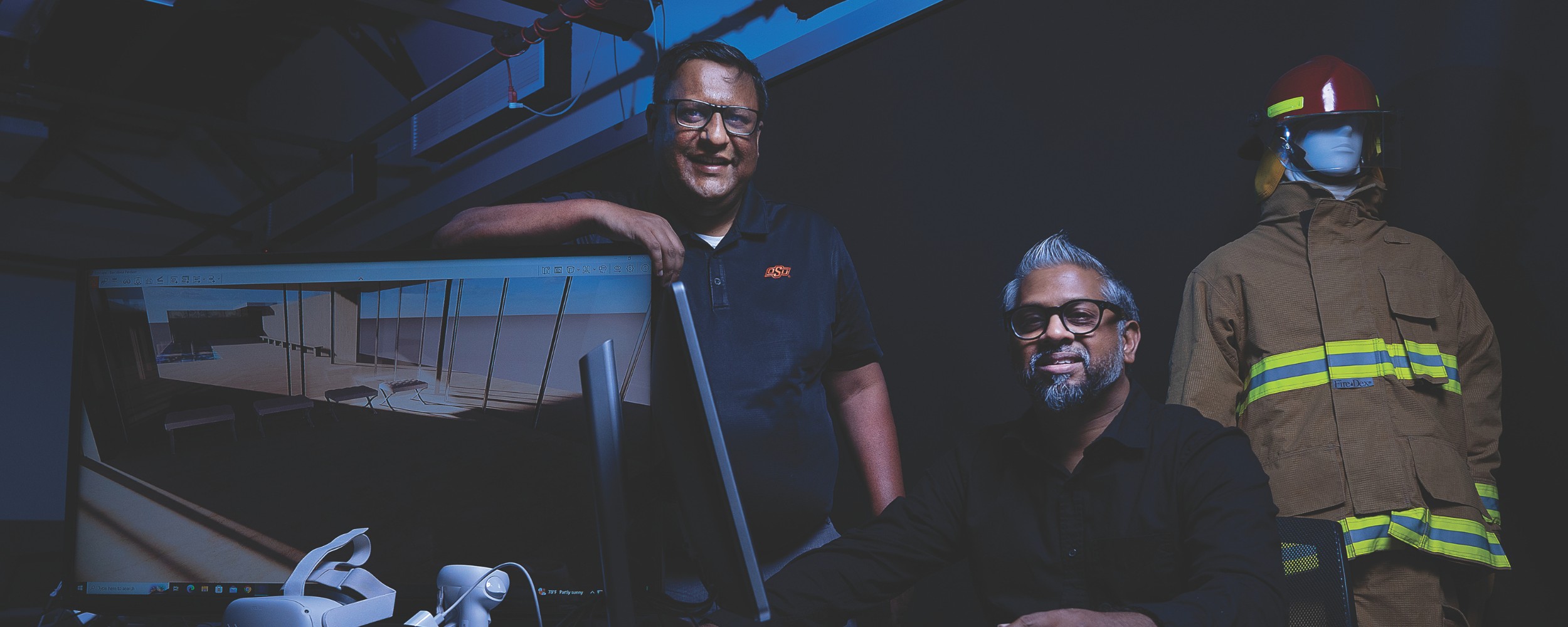
Reality Check: Design and Merchandising fixing the world’s problems through Mixed Reality Lab
Tuesday, October 15, 2024
Media Contact: Christy Lang | Director, Marketing and Communications | 405-744-9740 | christy.lang@okstate.edu
Beyond cutting-edge technology and groundbreaking research, the heart of Oklahoma State University’s Mixed Reality Lab lies in its commitment to education.
From artifact preservation to VR meat butchering, the lab aims to demystify MR technology and empower students and the public to shape the future of design.
Drs. Tilanka Chandrasekera and Aditya Jayadas from the College of Education and Human Sciences claim to be able to fix many problems within the sphere of MR. While many types of research can be expensive and out of reach, they can create simulations of almost anything.
For example, one student created full-size 3D printings of women throughout their pregnancy to create dress stands for them. Another entirely redesigned the airline snack cart to work better in the limited space. Nearly any problem can be fixed if it has been thought of within the walls of the Mixed Reality Lab.
The lab, established in 2015 by Chandrasekera and Jayadas in the Department of Design and Merchandising, has become a breeding ground for design innovation. It fosters a collaborative environment for students and faculty from various disciplines to utilize mixed reality technologies.
“On one side, you have virtual reality,” Chandrasekera said. “On the opposite side, you have the real world, and in the middle, you have augmented reality.”
Augmented reality bridges the physical and digital worlds by adding virtual elements to real surroundings. This improves perception and interaction with the environment. In contrast, virtual reality completely immerses users in a computer-generated world, detaching them from the physical one.
The Mixed Reality Lab goes beyond the typical image of a high-tech research facility. While it has an impressive array of equipment, including virtual reality stations, augmented reality devices, 3D printers, scanners and psychophysiological monitoring tools, its true strength lies in its multifaceted approach. This research elevates OSU as part of the We Are Land-Grant strategy.
The Mixed Reality Lab's research portfolio reflects the lab's commitment to tackling diverse design challenges. One ongoing project funded by the National Science Foundation focuses on preserving Native American artifacts. The lab uses 3D scanning technology to create high-fidelity digital representations of these artifacts, allowing for their virtual exhibition and safeguarding them for future generations. Soon, this information will be released on a website for the public to access.
Another project involves exploring the concept of "smart hotels." This project equips a hotel room with various smart devices and sensors to investigate how technology integration might impact guest experiences. The researchers wanted to see how people perceived smart rooms in hotels. This project was performed in the Atherton Hotel on OSU’s campus.
This commitment to purpose is evident in the lab's extensive outreach programs. Chandrasekera and Jayadas host workshops for K-12 students and the public throughout the year, illustrating MR technology and encouraging participants to explore its applications in their fields.
“We partner with multiple people across campus,” Chandrasekera said. “It doesn’t matter, as long as there’s a project we partner with psychology, education, engineering. We have a meeting with theatre. We’re trying to work with multiple people across different areas. The main intention is to take this state and show kids, or anyone, how approachable it is because we’ve set up tech centers and tribes with this technology.”
Collaboration is another cornerstone of the Mixed Reality Lab's philosophy. The lab actively seeks partnerships with researchers and faculty across OSU's diverse academic landscape. Beyond OSU, Chandrasekera and Jayadas have collaborated with universities worldwide.
“We host these really, really cool Designathons,” Jayadas said. “And we have students from different universities, not just in the U.S., (also) from Iran, Columbia, Sri Lanka and (more) .”
The Designathons last Friday through Sunday. Students are given a prompt on Friday, then on Saturday and the first half of Sunday, are given opportunities to solve the problem. Sunday afternoon, they present. One Designathon was related to space, so people from NASA were brought in as speakers for the event. All students are welcome to join, and it is usually hosted when time permits, either in the fall or spring semesters.
This collaborative spirit is exemplified by a project where the lab partnered with OSU engineering students to develop a VR training simulation for surgeons. The researchers looked to redesign the operating table to create a space for pregnant surgeons to perform their jobs better.
Chandrasekera and Jayadas address a common misconception about the lab's work.
“I think we do have visibility now, but I think more people could know about us,” Jayadas said. “Sometimes there’s a misconception thinking that ‘Oh, they just do decoration.’ I think most of that is wiped away, but I wanted to explicitly state that whether it’s in the sky, under the water, in space, or any task that anyone does, we can help improve the task.”
The lab actively promotes its capabilities and research findings to bridge this knowledge gap. The professors participate in conferences and workshops, showcasing their work and engaging with a broader audience.
The OSU Mixed Reality Lab demonstrates the power of collaboration and innovation. The lab revolutionizes how design is conceptualized, researched and executed by leveraging mixed reality technologies. Chandrasekera and Jayadas have a clear vision for the future: continually pushing the boundaries of design and promoting a more inclusive, user-centered approach to shaping future spaces and experiences.
“Putting a headset on a kid is easy, right?” Chandrasekera said. “You can put it on and let them play a game, but that’s not the purpose. You give them the tool and show them how they can use it in the future and their careers. Give them the steps. Once they have it, it’s up to them to use it in whatever discipline they’re in.”
Photos By: Kelly Kerr, Phil Shockley and Provided
Story By: Mak Vandruff | ASPIRE Magazine
